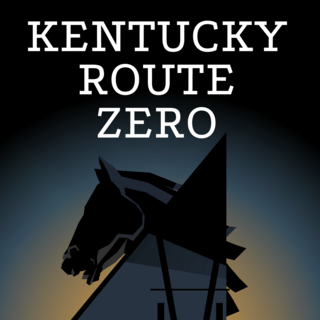INTRO:
The adventure game genre was a very crowded place, and perhaps still is. When considerable gameplay complexity is not needed, there can only be so much that can be done in terms of puzzle designs, writing, and character portrayals before things start to become stale for the purveyor of such games.
Some developers try to innovate by doing what others have yet to do. In the case of this game, it is to implement a seemingly believable yet bizarre setting.
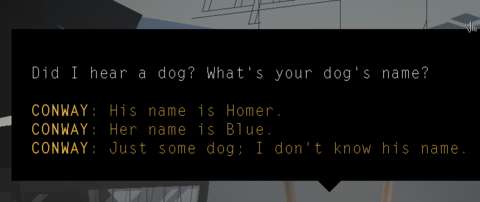
PREMISE:
The USA may be known for all kinds of things and portrayed as having them in video games. However, the extensive highway routes crossing the tracts of lands in the USA are rarely present in them, at least not those games that are inspired by Oregon Trail.
As practical reality necessitates, USA highway routes had been renamed or decommissioned as sections were closed or rerouted. To the people who could not understand such necessities, the closing of routes would have led minds to think of the missing numbered routes as mysterious, especially considering that vast expanses of land in the USA remain unfamiliar despite having already been charted.
That said, this game is about a fictitious route that is not in the official highway system: Route Zero.
A deliveryman by the name of Conway is presumably delivering antiques to a certain address that apparently is not on the maps. After realizing this, he stops at what is presumably a fuel station to ask for directions.
This is where the impression that something is not right begins to take form. The fuel station is peculiarly unpowered, and its owner is sitting outside on a couch, seemingly uncaring. After sending Conway on an errand down into the basement of the station, the surreal setting begins to make itself known.
Eventually, Conway would meet another protagonist, Sharon, and together they would find and journey through Route Zero. Along the way, they would meet other protagonists, and the player would wonder why they are not perturbed by the strange things that can be seen throughout the game.
POINT AND CLICK:
The player uses the mouse to direct where the player character should go to. In the case of objects that the player character can interact with, tooltips appear whenever the player character is near. These tooltips in turn contain buttons that the player can click on, thus having the player character interact with the associated objects. These designs prevent any ambiguity of having to select something from things that are close to each other, and also negate any possibility of pixel-hunting.
(Most competently designed adventure games would make sure that retrievable things are not close to each other, have high contrast and have considerable on-screen sizes.)
In addition to the segments where the player characters are clearly on-screen in recognizable environments, there are the driving segments. These may occur in the physical plane, where the player is shown the highway routes, including route 65, in a map-like display. Then, there are the segments in Route Zero, which is a loopy and bizarre path where turning around is a required way to get somewhere.
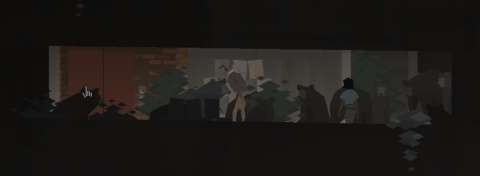
ON-RAILS:
Late into the game, the driving around is replaced with boat rides that are automatic. The player has to wait for the boat to eventually reach some location of interest. It happens quickly enough that it would be bearable in the first playthrough, but it is not likely welcome in any further replays of the game (if the player bothers to replay the Acts at all).
PLAYER CHARACTER SWITCHING:
Peculiarly, the game has the player’s control inputs changing from one player character to another without any notification or prompting. The player might notice this when the usual player character (such as Conway or Shannon) stops responding to any control input but another on-screen character does so instead, such as Ezra, a wild child that joins the group later.
At other times, the player’s controls switch to those for a newly introduced character, which can seem odd. Of course, it is something that is rarely done in adventure games, though the novelty is not really impressive since it does not contribute much to the storytelling. There is nothing that the player could do in these cases other than to have these new characters approach the protagonists.
WATCHING THE PLAYER CHARACTER MOVE ABOUT:
One of the complaints about adventure games is that player characters have to walk about from spots within a scene and from one scene to the next. This might seem like a petty complaint since the player characters have to do so anyway. Yet, there can only be so much entertainment to be had from watching the same movement animations over and over, especially if nothing eventful happens when the player character moves from one spot to another.
Most present-day adventure games address this issue by letting the player skip or accelerate the player character’s animations. This one does not, at least not in the first two Acts.
Therefore, the player would be watching the player character move about a lot; this becomes especially unpleasant after Conway sustains injuries to his leg.
There are some moments where this dreariness is salvaged by some interesting scripting, like Shannon helping Conway move about (which increases their walking speed). Unfortunately, these moments are too few.
After the first two Acts, player characters move much faster because they are running about instead of walking. Even so, some of the later scenes still have them walking about.
This also happens in the driving segments, especially in Route Zero. It can be bewildering to watch strange landmarks appear as the player tries to follow directions, which turn out to be quite useless in Route Zero because of its outlandishness.
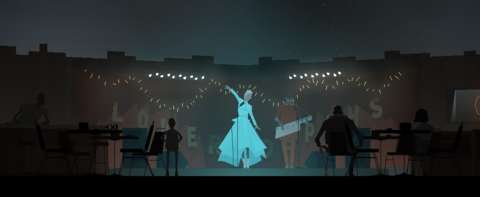
SKIP PROMPTS:
There had been complaints about the above during the episodic publication of the game. Therefore, the developers have included on-screen prompts to simply let the player skip entire optional tracts of the content in the later acts. Using the skips usually places the player characters at where they need to be in order to advance the storyline.
Although this meant skipping a lot of content, it also skips the aforementioned boring or bewildering parts. This would be useful for players that have already acknowledged the bizarre setting but would prefer to just hurry things along.
Some of the later skip prompts do not immediately place the player character at where they need to be, however. Rather, the game puts the player characters on auto-pilot.
DIALOGUE OPTIONS:
Much of the gameplay experience depends on the player’s dialogue choices, and the responses to these choices. Some choices that the player pick appear to influence certain occurrences later too, such as different remarks from NPCs or slightly different scenes.
The player should not expect completely divergent stories however. The game has been made according to a storyboard, and will not do things like completely stray off the overarching plot of the protagonists trying to find the destination of the delivery that Conway intends to make. Indeed, at moments where divergence can occur, the dialogue options are all similar to each other and they return to the main plot.
Rather, the dialogue options appear to be designed for exposition. For example, some of them have the player character reminiscing about old times before returning to the present. If the player does not care much for these, there is usually at least one option that focuses on the present; this one is usually clear, such as Shannon’s terse reminders on that task at hand.
By default, the dialogue options fade in quickly, but they do not appear instantly. However, holding down the mouse button accelerates this.
VISUAL DESIGNS:
People in this game are displayed as a collection of moving and coloured 2D shapes, rigged and oriented to look humanoid. The lack of any faces meant that body language matters more in their expressions. Fortunately, there is adequate effort that has been invested into making them obvious. However, the camera zoom levels and lighting do not always make this so.
The game is trying for some minimalist aesthetics, such as not having any complex textures, much less things like normal mapping. However, it does have considerable lighting effects, which result in visuals that appear to try reach for both ends of the level-of-detail scale. Of course, this was not the first game to do so – many indie games would do this too.
There are some interestingly peculiar designs though. For example, the game marks the spot where the player has clicked on with the display of a horseshoe-tossing game.
There are also frequent perspective changes. The camera is set at different angles (often far away), and have filters running through the display to impart impressions of different visual media. For example, there are security recordings of the occurrences at some of the venues where the player characters will go to.
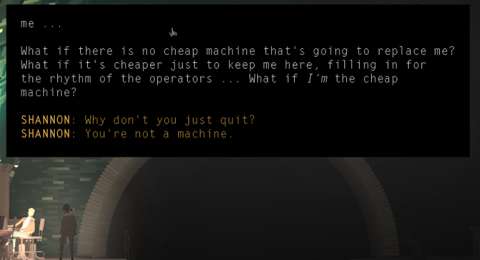
SOUND DESIGNS:
There are no voice-overs for the conversations; they occur in text. There is no narration either, text or voiced. There are some voice-overs in the final act, but these are for optional content and they are all phoned-in messages.
Many occurrences lack sound effects in the earlier Acts. Conway’s truck at least has sound effects that are associated with it, but mostly everything else that is not as loud as or louder than vehicles would not have any. The later Act has more sound effects, especially after the journey has gone on the water.
The ambient noises and music are the most significant parts of the game’s audio. Most of the ambient noises are generally appropriate to the current circumstances, and are dependent on the player character’s current location. For example, the player can hear elevator music when Conway and Shannon are using the elevators in the (fictitious) Bureau of Reclaimed Spaces.
As for the music, much of it is melancholic, possibly even sad to listen to. There are several songs with lyrics, the playing of which is usually indicated through the appearance of silhouettes of people playing instruments in the foreground.
CLOSING STATEMENTS:
At this time of writing, Act 5, the final act in the story, has yet to be released. Yet, it should be obvious to any observant story-goer that the game is going for a surreal yet familiar blend of story elements. There are bizarre things like glowing skeletons walking about and android musicians, and familiar things like finding one’s way in the world. This game would be very appealing to people who want very different story-telling in their games.
On the other hand, the balancing of the surreal yet familiar might not be palatable to those with a sense of disbelief. Many bizarre occurrences in the game would go unquestioned by characters, such as the aforementioned glowing skeletons walking around and a highway route and a river that goes completely underground. If the player is bewildered by these, there is not a lot of explanation forthcoming.
Unfortunately, this game repeats a design shortfall that had been long addressed in other point-and-click adventure games, which is that player characters move about at their own pace instead of the player’s. Characters walk slowly in scenes where there is not a lot to see as they move about, and leaving on the truck is not a quick affair. The developers eventually implemented skipping mechanics, but the first act made it obvious that they had not thought of this.
